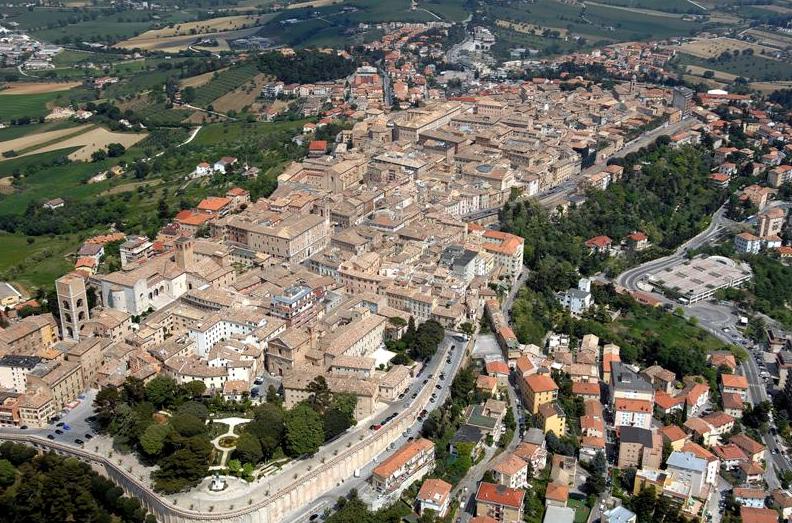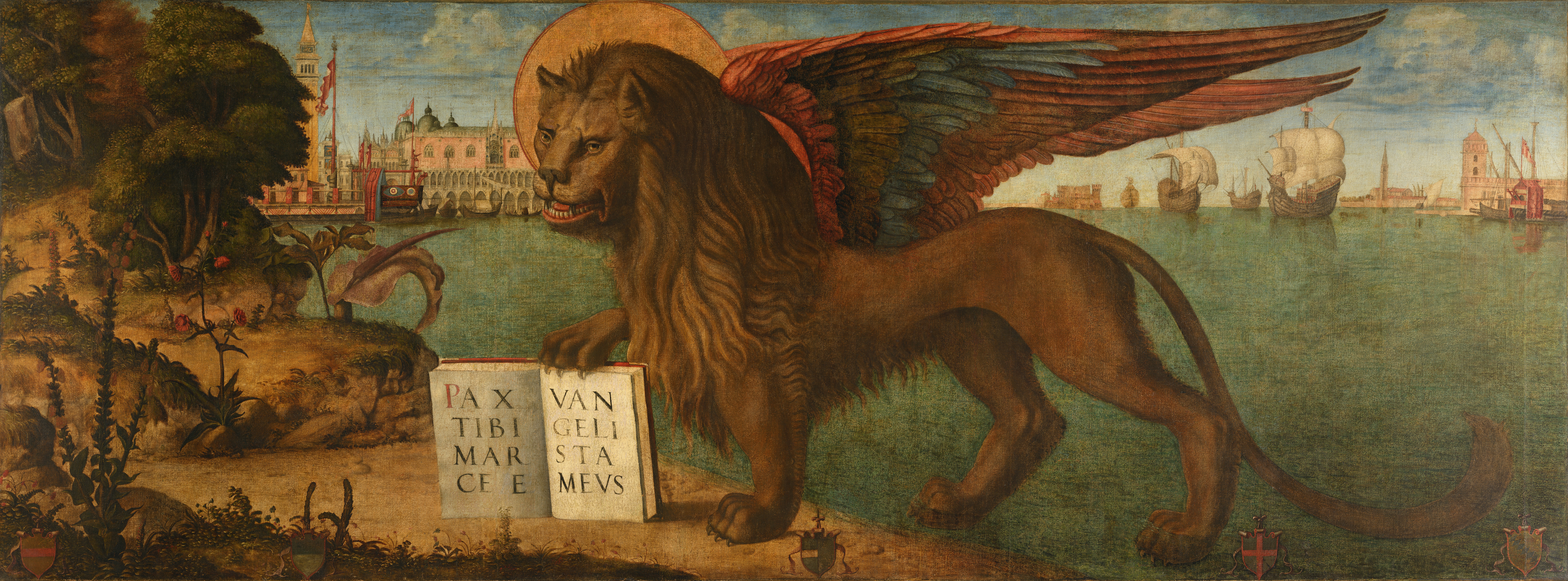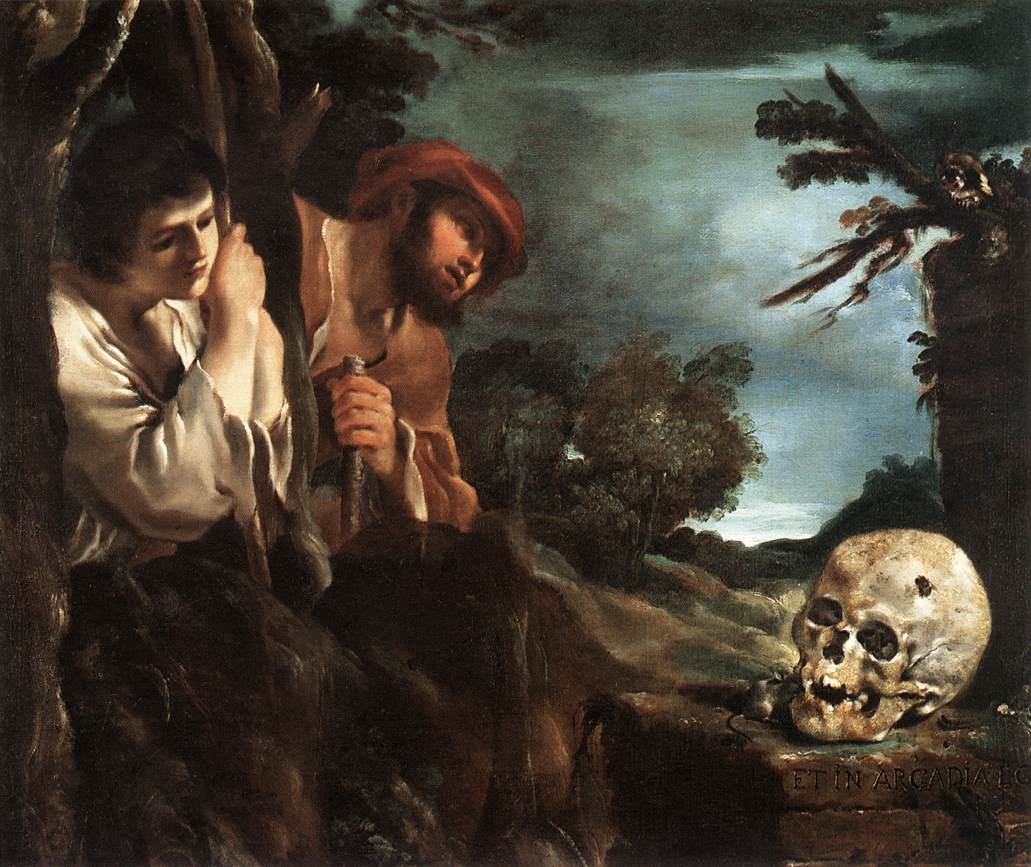|
San Marco Evangelista, Osimo
San Marco Evangelista is a Roman Catholic church in the town of Osimo, region of Marche, Italy. History A church at the site, dedicated to Saint Mark the Evangelist, was erected in the 14th century by the Augustinian order adjacent to their convent, later becoming a hospital for the poor. The church underwent restoration after the church passed in the 15th century to the care of the Dominican order, who officiated in the church from 1428 to 1920. The interiors are now baroque in style The interior conserves a number of artworks, including a 15th-century fresco in a lateral altar depicting the ''Enthroned Madonna with Child and Saints Dominic and Peter Martyr'' attributed by some to Arcangelo di Cola of Camerino or Pietro di Domenico of Montepulciano. In the choir is an altarpiece depicting the ''Madonna of the Rosary with St Dominic and Catherine of Siena'' (1642) by Guercino Giovanni Francesco Barbieri (February 8, 1591 – December 22, 1666),Miller, 1964 better known as Guerci ... [...More Info...] [...Related Items...] OR: [Wikipedia] [Google] [Baidu] |
Roman Catholic
Roman or Romans most often refers to: *Rome, the capital city of Italy *Ancient Rome, Roman civilization from 8th century BC to 5th century AD *Roman people, the people of ancient Rome *'' Epistle to the Romans'', shortened to ''Romans'', a letter in the New Testament of the Christian Bible Roman or Romans may also refer to: Arts and entertainment Music * Romans (band), a Japanese pop group * ''Roman'' (album), by Sound Horizon, 2006 * ''Roman'' (EP), by Teen Top, 2011 *" Roman (My Dear Boy)", a 2004 single by Morning Musume Film and television * Film Roman, an American animation studio * ''Roman'' (film), a 2006 American suspense-horror film * ''Romans'' (2013 film), an Indian Malayalam comedy film * ''Romans'' (2017 film), a British drama film * ''The Romans'' (''Doctor Who''), a serial in British TV series People *Roman (given name), a given name, including a list of people and fictional characters *Roman (surname), including a list of people named Roman or Romans *Ῥωμ� ... [...More Info...] [...Related Items...] OR: [Wikipedia] [Google] [Baidu] |
Osimo
Osimo is a town and ''comune'' of the Marche region of Italy, in the province of Ancona. The municipality covers a hilly area located approximately south of the port city of Ancona and the Adriatic Sea. , Osimo had a total population of 35,037. History Vetus Auximum was founded by the same Greek colonists of Ancona; later it was contested by the Gauls and the Picentes until conquered by the Romans, who used it as a fortress for their northern Picenum settlement starting from 174 BCE. The walls were made of large rectangular stones which are still visible in some locations. It was a colony until 157 BCE. The family of Pompey were its protectors and resisted Julius Caesar in 49 BCE. Inscriptions and monuments in its town square attest to the importance of Osimo during imperial times. In the 6th century it was besieged twice in the course of the Gothic War (535–554) by Belisarius and Totila; the Byzantine historian Procopius said it was the leading town of Picenum. Osimo was a ... [...More Info...] [...Related Items...] OR: [Wikipedia] [Google] [Baidu] |
Marche
Marche ( , ) is one of the twenty regions of Italy. In English, the region is sometimes referred to as The Marches ( ). The region is located in the central area of the country, bordered by Emilia-Romagna and the republic of San Marino to the north, Tuscany to the west, Umbria to the southwest, Abruzzo and Lazio to the south and the Adriatic Sea to the east. Except for river valleys and the often very narrow coastal strip, the land is hilly. A railway from Bologna to Brindisi, built in the 19th century, runs along the coast of the entire territory. Inland, the mountainous nature of the region, even today, allows relatively little travel north and south, except by twisting roads over the passes. Urbino, one of the major cities of the region, was the birthplace of Raphael, as well as a major centre of Renaissance history. Toponymy The name of the region derives from the plural of the medieval word '' marca'', meaning "march" or "mark" in the sense of border zone, originall ... [...More Info...] [...Related Items...] OR: [Wikipedia] [Google] [Baidu] |
Mark The Evangelist
Mark the Evangelist ( la, Marcus; grc-gre, Μᾶρκος, Mârkos; arc, ܡܪܩܘܣ, translit=Marqōs; Ge'ez: ማርቆስ; ), also known as Saint Mark, is the person who is traditionally ascribed to be the author of the Gospel of Mark. According to Church tradition, Mark founded the episcopal see of Alexandria, which was one of the five most important sees of early Christianity. His feast day is celebrated on April 25, and his symbol is the winged lion. Mark's identity According to William Lane (1974), an "unbroken tradition" identifies Mark the Evangelist with John Mark, and John Mark as the cousin of Barnabas. However, Hippolytus of Rome in ''On the Seventy Apostles'' distinguishes Mark the Evangelist (2 Tim 4:11), John Mark (Acts 12:12, 25; 13:5, 13; 15:37), and Mark the cousin of Barnabas (Col 4:10; Phlm 1:24). According to Hippolytus, they all belonged to the "Seventy Disciples" who were sent out by Jesus to disseminate the gospel (Luke 10:1ff.) in Judea. Accord ... [...More Info...] [...Related Items...] OR: [Wikipedia] [Google] [Baidu] |
Augustinian Order
Augustinians are members of Christian religious orders that follow the Rule of Saint Augustine, written in about 400 AD by Augustine of Hippo. There are two distinct types of Augustinians in Catholic religious orders dating back to the 12th–13th centuries: * Various congregations of Canons Regular also follow the Rule of Saint Augustine, embrace the evangelical counsels and lead a semi-monastic life, while remaining committed to pastoral care appropriate to their primary vocation as priests. They generally form one large community which might serve parishes in the vicinity, and are organized into autonomous congregations. * Several orders of friars who live a mixed religious life of contemplation and apostolic ministry. The largest and most familiar is the Order of Saint Augustine (OSA), founded in 1244 and originally known as the Hermits of Saint Augustine (OESA). They are commonly known as the Austin Friars in England. Two other orders, the Order of Augustinian Recollects and ... [...More Info...] [...Related Items...] OR: [Wikipedia] [Google] [Baidu] |
Dominican Order
The Order of Preachers ( la, Ordo Praedicatorum) abbreviated OP, also known as the Dominicans, is a Catholic mendicant order of Pontifical Right for men founded in Toulouse, France, by the Spanish priest, saint and mystic Dominic of Caleruega. It was approved by Pope Honorius III via the papal bull ''Religiosam vitam'' on 22 December 1216. Members of the order, who are referred to as ''Dominicans'', generally carry the letters ''OP'' after their names, standing for ''Ordinis Praedicatorum'', meaning ''of the Order of Preachers''. Membership in the order includes friars, nuns, active sisters, and lay or secular Dominicans (formerly known as tertiaries). More recently there has been a growing number of associates of the religious sisters who are unrelated to the tertiaries. Founded to preach the Gospel and to oppose heresy, the teaching activity of the order and its scholastic organisation placed the Preachers in the forefront of the intellectual life of the Middle Ag ... [...More Info...] [...Related Items...] OR: [Wikipedia] [Google] [Baidu] |
Arcangelo Di Cola
Arcangelo di Cola (active 1416–1429) was an Italian painter, active throughout central Italy in a late Gothic style. He was born in Camerino, but it is unknown where he trained, but was influenced by Gentile da Fabriano. He was known in 1416 to be painting frescoes in the Palazzo comunale of Città di Castello. In 1420, he had been inscribed in the guild of painters in Florence. He painted in 1421 a canvas now lost for the Florentine church of Santa Lucia dei Magnoli. In 1422, he was recruited by Pope Martin V to Rome, then sent to fresco the Oratory of the Annunziata at Riofreddo in the region of the Lazio it, Laziale , population_note = , population_blank1_title = , population_blank1 = , demographics_type1 = , demographics1_footnotes = , demographics1_title1 = , demographics1_info1 = , demographics1_title2 .... He is best known for a triptych (1425) painted for the Monastero dell'Isola in Marche. In 1899, the piece was dismembere ... [...More Info...] [...Related Items...] OR: [Wikipedia] [Google] [Baidu] |
Pietro Di Domenico
Pietro di Domenico, also Pietro di Domenico da Siena, (1457–1506) was an Italian Renaissance painter. Not much is known about Pietro di Domenico's life except through his works. He was born, worked, and lived all his life in Siena, and his style puts him in the Sienese School, and shows influences of the painter Luca Signorelli. He primarily painted religious-themed works for local church commissions. He died in Siena in 1506. One of his works is part of the York Museums Trust York Museums Trust (YMT) is the charity responsible for operating some key museums and galleries in York, England. The trust was founded in 2002 to run York's museums on behalf of the City of York Council. It has seen an increase in annual foo ... collection. References External links''Italian Paintings: Sienese and Central Italian Schools'' a collection catalog containing information about Domenico and his works (see index; plate 73). 1457 births 1506 deaths 15th-century Italian painters ... [...More Info...] [...Related Items...] OR: [Wikipedia] [Google] [Baidu] |
Guercino
Giovanni Francesco Barbieri (February 8, 1591 – December 22, 1666),Miller, 1964 better known as Guercino, or il Guercino , was an Italian Baroque painter and draftsman from Cento in the Emilia region, who was active in Rome and Bologna. The vigorous naturalism of his early manner contrasts with the classical equilibrium of his later works. His many drawings are noted for their luminosity and lively style. Biography Giovanni Francesco Barbieri was born into a family of peasant farmers in Cento, a town in the Po Valley mid-way between Bologna and Ferrara.Mahon, 1937a Being cross-eyed, at an early age he acquired the nickname by which he is universally known, Guercino (a diminutive of the Italian noun '' guercio'', meaning 'squinter').Turner, 2003 Mainly self-taught, at the age of 16, he worked as apprentice in the shop of Benedetto Gennari, a painter of the Bolognese School. An early commission was for the decoration with frescos (1615–1616) of Casa Pannini in Cento, wher ... [...More Info...] [...Related Items...] OR: [Wikipedia] [Google] [Baidu] |
14th-century Roman Catholic Church Buildings In Italy
As a means of recording the passage of time, the 14th century was a century lasting from 1 January 1301 ( MCCCI), to 31 December 1400 ( MCD). It is estimated that the century witnessed the death of more than 45 million lives from political and natural disasters in both Europe and the Mongol Empire. West Africa experienced economic growth and prosperity. In Europe, the Black Death claimed 25 million lives wiping out one third of the European population while the Kingdom of England and the Kingdom of France fought in the protracted Hundred Years' War after the death of Charles IV, King of France led to a claim to the French throne by Edward III, King of England. This period is considered the height of chivalry and marks the beginning of strong separate identities for both England and France as well as the foundation of the Italian Renaissance and Ottoman Empire. In Asia, Tamerlane (Timur), established the Timurid Empire, history's third largest empire to have been ever establish ... [...More Info...] [...Related Items...] OR: [Wikipedia] [Google] [Baidu] |






